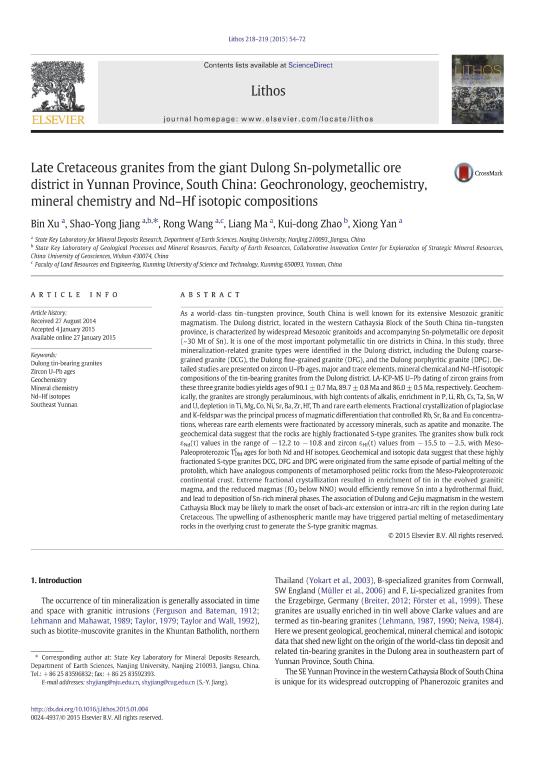

Bin Xua, Late Cretaceous granites from the giant Dulong Sn-polymetallic ore district in Yunnan Province, South China: Geochronology, geochemistry, mineral chemistry and Nd–Hf isotopic compositions
As a world-class tin–tungsten province, South China is well known for its extensive Mesozoic granitic magmatism. The Dulong district, located in the western Cathaysia Block of the South China tin–tungsten province, is characterized by widespread Mesozoic granitoids and accompanying Sn-polymetallic ore deposit (~30 Mt of Sn). It is one of the most important polymetallic tin ore districts in China. In this study, three mineralization-related granite types were identified in the Dulong district, including the Dulong coarsegrained granite (DCG), the Dulong fine-grained granite (DFG), and the Dulong porphyritic granite (DPG). Detailed studies are presented on zircon U–Pb ages, major and trace elements, mineral chemical and Nd–Hf isotopic compositions of the tin-bearing granites from the Dulong district. LA-ICP-MS U–Pb dating of zircon grains from these three granite bodies yields ages of 90.1 ± 0.7 Ma, 89.7 ± 0.8 Ma and 86.0 ± 0.5 Ma, respectively. Geochemically, the granites are strongly peraluminous, with high contents of alkalis, enrichment in P, Li, Rb, Cs, Ta, Sn, W and U, depletion in Ti, Mg, Co, Ni, Sr, Ba, Zr, Hf, Th and rare earth elements. Fractional crystallization of plagioclase and K-feldspar was the principal process of magmatic differentiation that controlled Rb, Sr, Ba and Eu concentrations, whereas rare earth elements were fractionated by accessory minerals, such as apatite and monazite. The geochemical data suggest that the rocks are highly fractionated S-type granites. The granites show bulk rock εNd(t) values in the range of -12.2 to -10.8 and zircon εHf(t) values from -15.5 to -2.5, with MesoPaleoproterozoic TDM C ages for both Nd and Hf isotopes. Geochemical and isotopic data suggest that these highly fractionated S-type granites DCG, DFG and DPG were originated from the same episode of partial melting of the protolith, which have analogous components of metamorphosed pelitic rocks from the Meso-Paleoproterozoic continental crust. Extreme fractional crystallization resulted in enrichment of tin in the evolved granitic magma, and the reduced magmas (fO2 below NNO) would efficiently remove Sn into a hydrothermal fluid, and lead to deposition of Sn-rich mineral phases. The association of Dulong and Gejiu magmatism in the western Cathaysia Block may be likely to mark the onset of back-arc extension or intra-arc rift in the region during Late Cretaceous. The upwelling of asthenospheric mantle may have triggered partial melting of metasedimentary rocks in the overlying crust to generate the S-type granitic magmas.
